Uncover insights to elevate your in-app communications, turning users into loyal customers. Transform your approach to customer experience with our Singapore Consumer Engagement Report 2023.
In an age where digital communication is everywhere, there’s still something special about a human voice in customer service.
Consider this: recent findings reveal that over half of consumers in Singapore still prefer human interactions for customer service, with 21% specifically choosing to speak with someone on the phone. This statistic not only highlights the enduring value of voice communication but also underscores the importance of empowering frontline service employees.
Agents are often the first point of human contact when consumers are looking for customer support – which also happens to be the touchpoint at which customers most often feel frustrated or confused.
This makes the agent’s role crucial in providing that genuine, empathetic conversation customers seek. The authentic human connection over the phone, offering what texts and robots can’t, remains a critical element in customer support.
Considering the significant preference for human voice in customer support, it begs the question:
How well are companies in Singapore meeting this expectation? Are they truly delivering effective support with a human voice?
To help companies better understand these issues, we dedicated a significant portion of the Toku Singapore Consumer Engagement Report 2023 to them.
You can check out the full report, which also contains a wealth of insights on the evolving customer experience (CX) landscape in Singapore.
>> Get Access to Toku Singapore Consumer Engagement Report 2023
In this article, we’ll summarise some of the key findings that point towards the inescapable conclusion that the human voice is a potent weapon to have in your CX arsenal when building trust with customers.
Preferences for phone customer support
Overall, we found 68% of Singapore consumers prefer voice support when resolving product or service issues. However, there are notable generational differences. Here’s the breakdown by age groups of those who prefer to resolve issues over a phone call:
- 52% of those aged 18-24
- 67% of those aged 45-54
- 75% of those aged 55-65
While it might be tempting based on these numbers, to deprioritise phone support for the younger generation, such a move could be premature and potentially detrimental.
Completely eliminating phone support risks alienating some customers and could lead to a gap in service for those who may seek phone support in more complex or urgent scenarios.
Think about it: there’s always a situation where you would want to speak to customer support over the phone.
The question is:
Which use cases are more likely to have customers reaching out to an agent over the phone for support?
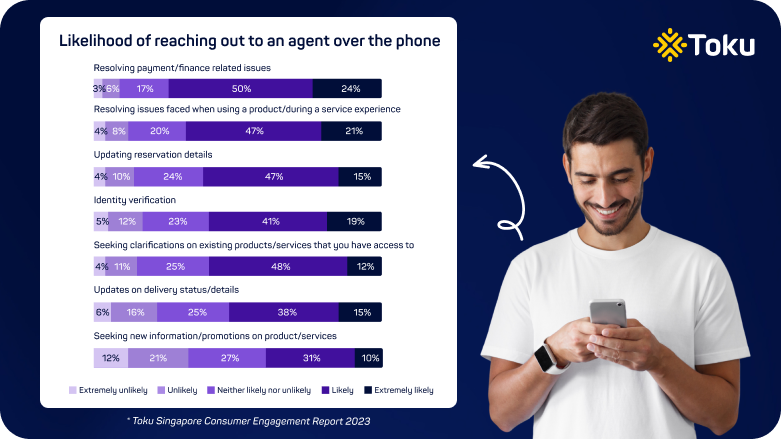
We dove into the data and found that out of all the scenarios above, payment/finance- related issues had the highest proportion of consumers opting for phone communication (74%).
Imagine you’re facing a payment issue or awaiting an urgent bank transfer confirmation.
In such critical moments, the reassurance of a human voice, the ability to ask questions and receive instant, nuanced responses, is priceless. The value lies in the clarity and trust that direct voice communication fosters – elements that are often vital during financial transactions where there is very little room for error.
This is a crucial consideration for businesses as they strategise their customer engagement across various channels, especially for services intertwined with financial security.
We recommend maintaining a balanced approach: while focusing on digital and self-service channels for the younger demographic, businesses should continue offering phone support as a valuable alternative. This approach ensures all customers have access to their preferred form of support and enhances overall customer satisfaction across all age groups.
How long are people willing to wait for an agent to answer their call?
In last year’s Toku Singapore Consumer Engagement Report, we noted that in general, Singapore consumers expect a response over the phone in under 5 minutes.
This year, we went one step further and asked:
How long are Singapore consumers willing to wait for an agent to pick up a call for different use cases?
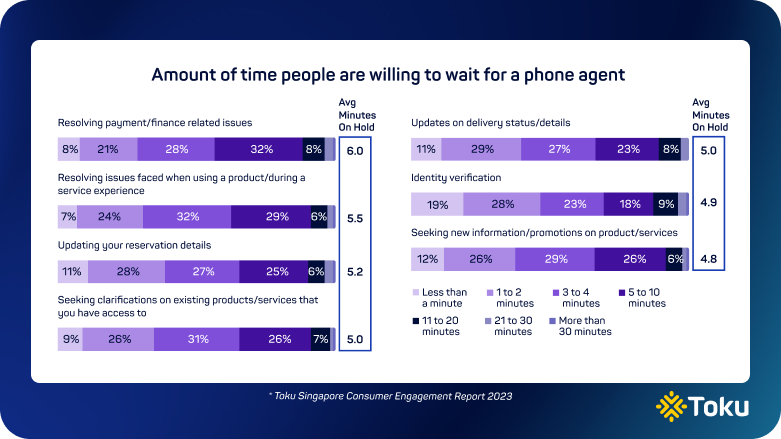
Once again, payment/finance- related issues took centrestage, accruing the longest waiting time (Average of 6 minutes). This reflects the high time premium consumers place on discussing these complex transactions thoroughly with a trusted representative.
We also discovered some other interesting insights related to waiting times. For instance,
- Consumers are less patient for simpler tasks like identity verification, for which the waiting time is only 4.9 minutes on average.
- When it comes to simpler tasks like identity verification, once the timer hits four minutes, over 75% of individuals aged 45 and above are ready to jump ship.
For a full discussion of these findings and our recommendations on how to leverage them in your CX, check out our report here:
>> Download Toku Singapore Consumer Engagement Report 2023
Navigating consumer frustrations in voice call support
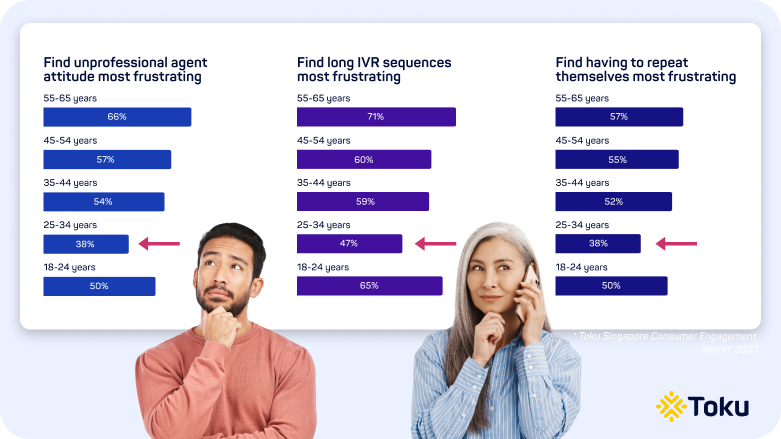
When it comes to voice call support, consumers of all ages share 3 common top frustrations.
- Having to endure never-ending interactive voice response (IVR) sequences before finally connecting with an agent.
- The attitude and professionalism of customer support agents.
- The need for customers to repeat themselves during the call.
How should businesses tackle these frustrations?
To address the first issue, adopting smarter, more streamlined IVR processes is essential. These should be designed to swiftly and efficiently guide customers to the most appropriate department to resolve their issue, minimising unnecessary delays and complexities.
With regards to meeting expectations for a certain level of professionalism and empathy, it’s vital for agents to receive training that enables them to understand and meet the varied expectations of different age groups. This approach is particularly crucial in today’s customer service landscape, where a one-size-fits-all approach no longer suffices.
As for the problem of repetitive questions, it’s imperative for businesses to adopt systems – such as an omnichannel contact centre platform – that would allow customer information and context to be captured and passed seamlessly between agents all in one place no matter the channel, ensuring that each interaction is informed and efficient.
Interestingly, while these frustrations are common across all age groups, millennials often stand apart.
Compared to other age groups, a smaller proportion of millennials express annoyance with these aspects of voice support.
This disparity could be attributed to their greater familiarity and comfort with digital alternatives and self-service options, potentially leading to greater tolerance for hiccups in the customer journey.
How can businesses leverage this insight on greater millennial tolerance levels?
One possible strategy is to run your beta tests for new service features or processes on millennials, because you’d be taking advantage of their forgiving nature.
Seamless, hiccup-free call experiences are still important
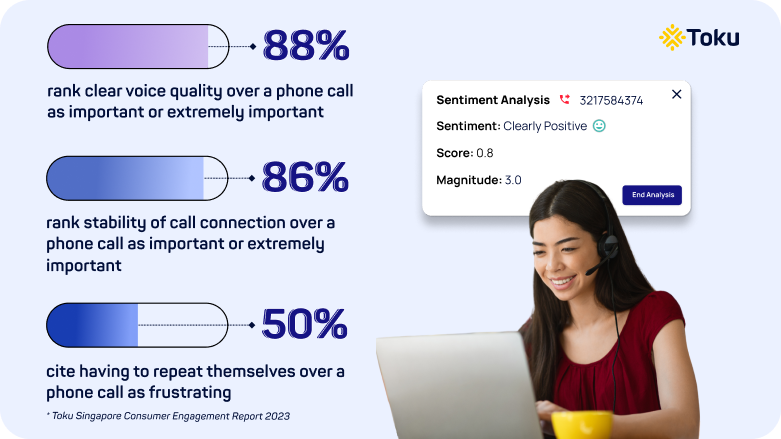
Clear and stable voice calls are the foundation of a seamless phone interaction as revealed by the numbers here with 88% (clear voice quality) and 86% (stability of call connection) of consumers ranking these aspects as important or extremely important in a phone call.
Notably, we discovered that 50% find repeating themselves over the phone frustrating.
We believe these statistics point to a broader desire for seamless, smoother, and generally more effortless phone interactions that don’t impose unnecessary burdens on the customer.
To meet this expectation, businesses should focus on:
- Building stable and clear call connections as the backbone of all interactions,
- Investing in technology such as an omnichannel contact centre platform to streamline access to contextual customer details gathered from prior interactions and avoid agents having to ask for information that’s already been provided.
Building effortless customer experiences warrants its own dedicated conversation, which is why we’ve explored this topic extensively in another blog post here:
>> Check Out: Building Effortless Experiences Using Best Service is No Service
The importance of phone number localisation
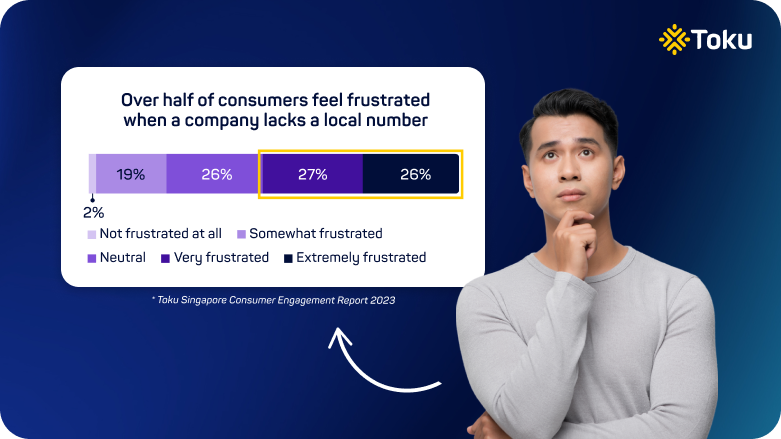
Have you ever thought about how it feels like to contact a company, only to find they do not have a local phone number?
In the first place, not having a local number leads to unnecessary frustration, as evident from over half of our respondents who say they would feel frustrated when faced with this situation.
If you think this frustration is just a momentary inconvenience, think again.
We believe it can lead to a negative perception of the company because not having a local number could be construed by customers as you being ‘a distant entity’ that cannot be really trusted.
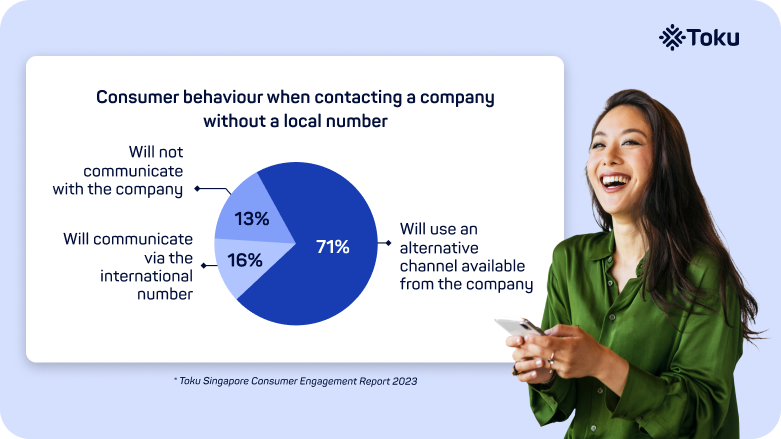
Secondly, consumers will tend to seek out alternative channels if a local number is unavailable.
This can strain other aspects of a business’s customer service system, leading to increased waiting times and a diluted service experience in these other channels, which further compounds the problem of deteriorating customer satisfaction.
Key takeaway:
Invest in local phone numbers to signal your commitment to being a part of the local community, enhancing reliability and trustworthiness.
Adapting to consumer preferences in phone support
In conclusion, phone support remains an indispensable facet of customer service.
It is crucial for fostering trust and loyalty, especially for handling complex issues where the human touch is critical. While acknowledging that younger generations might lean towards digital channels, maintaining phone support as an alternative is vital to accommodate diverse preferences.
Understanding the nuances of call waiting times is key. Customers show greater tolerance for longer waits in complex scenarios like finance-related queries, provided they are assured of skilled human assistance at the end of the wait.
Automation, particularly for straightforward tasks like identity verification, is rapidly becoming more important, striking a balance between efficiency and customer satisfaction.
Finally, leveraging technology such as omnichannel contact centres in your voice call experience is not just about streamlining operations—it’s about amplifying the trust that the human voice naturally builds. By efficiently consolidating customer interactions and responding empathetically, businesses can reinforce their commitment to providing a customer experience where the human touch remains central, even in an increasingly digital world.
 Nora Huin
Nora Huin 



 Monnan Miah
Monnan Miah 
 Girish Dharmaraj
Girish Dharmaraj